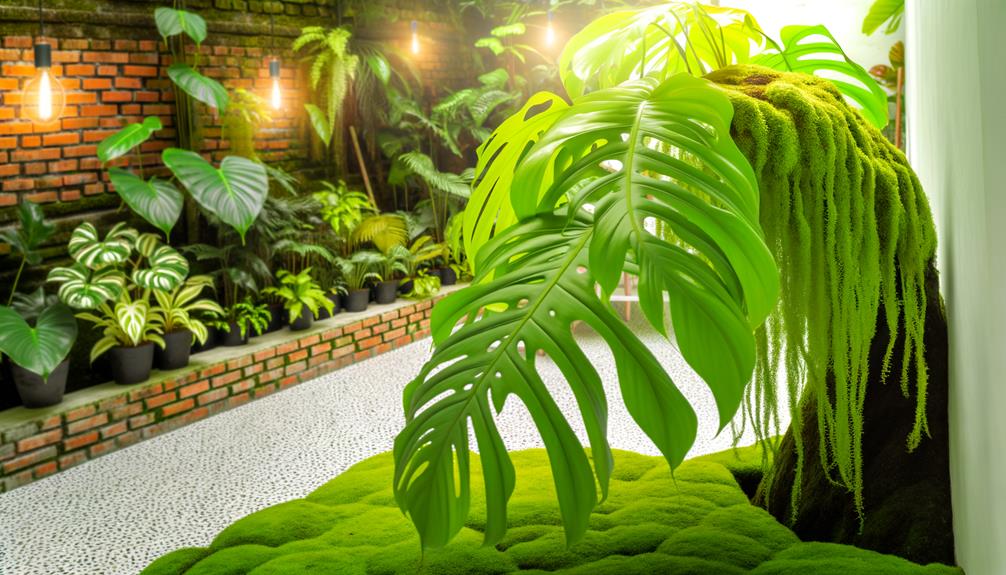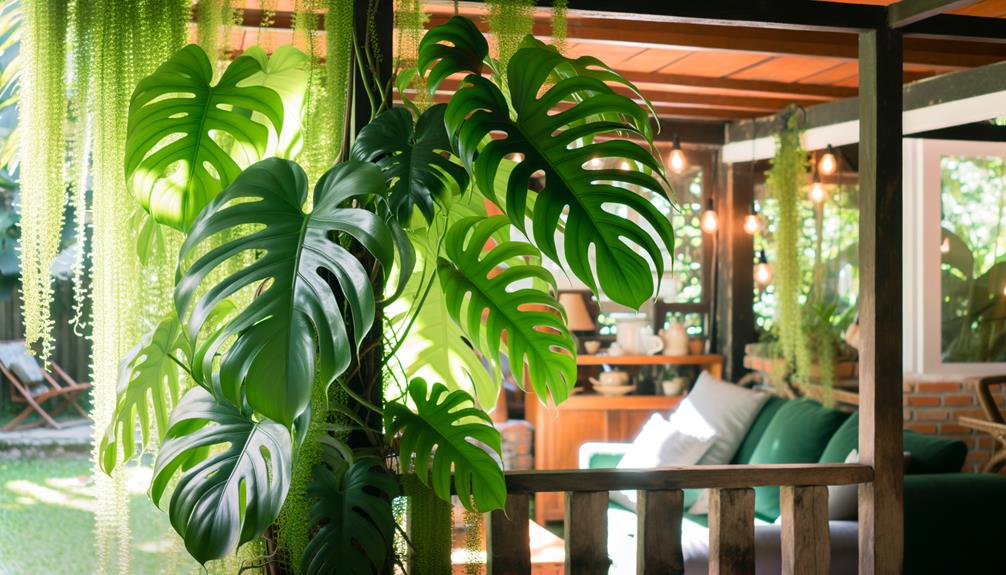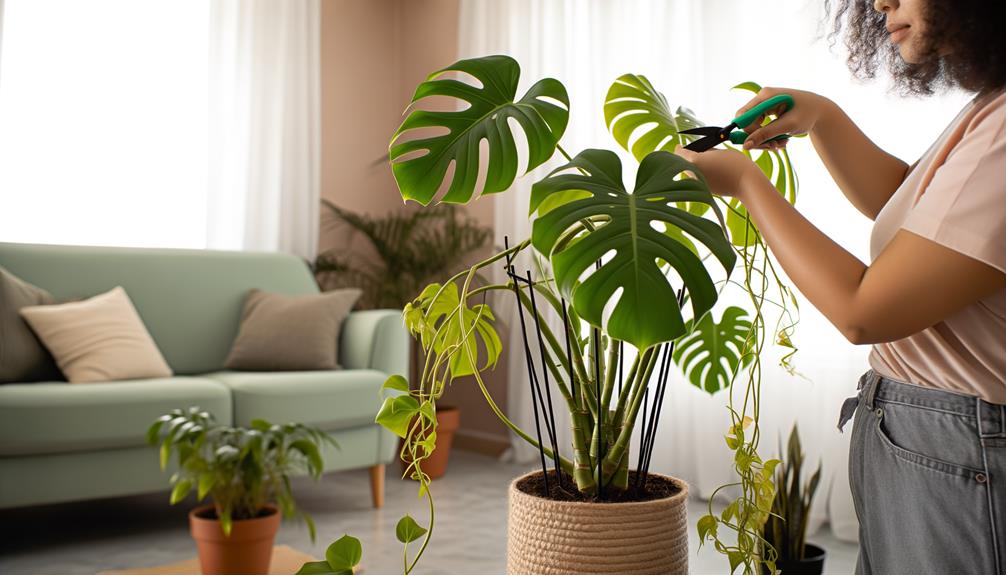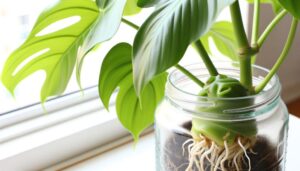Climbing Full Grown Climbing Monstera Adansonii: Care Tips!
To nurture a full-grown climbing Monstera Adansonii, provide a sturdy support structure like a moss pole for its aerial roots to grasp. Position it in bright, indirect light while maintaining temperatures between 65-85°F.
Water when the top inch of soil dries, ensuring adequate drainage to prevent root rot. Regular pruning and training help shape the plant and encourage healthy growth.
Secure stems to supports with soft ties to guide climbing. Monitor for pests and use neem oil or insecticidal soap if necessary.
Ensuring ideal conditions will promote vigorous growth and a lush appearance, revealing deeper care techniques.

Key Takeaways
- Provide Vertical Support: Use a sturdy moss pole or trellis to support and guide the climbing growth of a full-grown Monstera Adansonii.
- Secure Aerial Roots: Attach aerial roots to the support structure using soft plant ties or twine for stability and optimal growth.
- Ensure Adequate Light: Position the plant in bright, indirect sunlight to promote healthy climbing and leaf development.
- Maintain Humidity: Keep moderate to high humidity levels and mist the leaves regularly to support vigorous growth.
- Prune Regularly: Perform selective pruning to control size, shape, and encourage bushier, healthier growth.
Understanding Growth Patterns

To understand the growth patterns of Monstera adansonii, you need to examine how its aerial roots and vining habits enable it to thrive in its natural environment.
This plant, native to tropical rainforests, uses aerial roots to anchor itself to trees, enhancing its stability and access to sunlight. These roots absorb moisture and nutrients from the air and surrounding organic matter, which supports its vigorous growth.
The vining nature allows it to climb towards light, optimizing photosynthesis. Each node along the vine can produce new roots and leaves, facilitating rapid expansion.
Choosing the Right Support
Choosing the proper support structure for your Monstera adansonii is crucial to imitate its natural climbing behavior and achieve optimal growth. Opt for a moss pole or a trellis; both provide vertical support and encourage aerial roots to anchor. Make sure the pole is strong and tall enough to accommodate future growth.
Secure the plant to the support using soft ties, but avoid constricting the stems. Regularly check and adjust the ties as the plant grows. When setting up the support, place it near the plant’s base to guide upward growth effectively. Additionally, keep the moss pole moist to encourage root adhesion.
Appropriate support won’t only boost growth but also enhance overall plant health.
Ideal Light and Temperature

To guarantee your Monstera Adansonii thrives, provide it with bright, indirect sunlight, as direct sun can scorch its leaves.
Maintain a temperature range between 65-85°F, avoiding sudden drops which can stress the plant.
Adjust light exposure seasonally, ensuring it gets adequate light during shorter winter days.
Optimal Sunlight Conditions
For Monstera Adansonii to thrive, it requires bright, indirect sunlight and temperatures ranging between 65°F and 85°F.
Position your plant near a north or east-facing window where it can receive filtered light. Direct sunlight should be avoided as it can scorch the leaves, causing brown spots and damage. If natural light is insufficient, use grow lights to provide the necessary luminosity.
Monitor your plant’s exposure, ensuring it gets at least 10-12 hours of light daily. Additionally, avoid placing it in drafty areas or near heating vents.
Temperature Tolerance Range
Maintaining your Monstera Adansonii‘s thriving involves keeping a consistent temperature range between 65°F and 85°F. This plant prefers stable conditions, avoiding sudden temperature fluctuations. If temperatures drop below 60°F, the plant’s growth can slow dramatically, leading to potential stress and damage. Conversely, temperatures exceeding 90°F can cause leaf burn and dehydration.
Ideally, place your Monstera Adansonii in a room where the temperature remains steady. Avoid drafty windows, air vents, and direct exposure to heaters or air conditioners. Monitoring room temperature with a reliable thermometer can help you maintain the ideal range.
Seasonal Light Adjustments
Adjusting the light and temperature for your Monstera Adansonii according to the seasons promotes ideal growth and health.
During the spring and summer, place your plant in bright, indirect light to promote vigorous growth. As the days shorten in fall and winter, decrease light exposure to mimic natural conditions.
Monitor indoor temperatures, maintaining them between 65-75°F, and avoid sudden fluctuations.
- Spring/Summer: Guarantee bright, indirect light and maintain temperatures around 70-75°F.
- Fall/Winter: Gradually decrease light exposure and guarantee temperatures stay above 65°F.
- Artificial Lighting: Use grow lights if natural light is insufficient, maintaining a consistent 12-hour light cycle.
Watering and Feeding
Proper watering and feeding routines are fundamental for maintaining the health and vibrancy of your Monstera Adansonii.
Water your plant when the top inch of soil feels dry to the touch. Overwatering can lead to root rot, so make sure the pot has good drainage. Use room-temperature water to avoid shocking the roots.
Feed your Monstera monthly during the growing season (spring and summer) with a balanced, water-soluble fertilizer diluted to half strength. During the dormant period (fall and winter), reduce feeding to every six to eight weeks.
Monitoring the plant’s foliage is vital; yellow leaves often indicate overwatering, while brown tips can signal underwatering or low humidity.
Adhering to these guidelines will promote robust growth and lush foliage.
Pruning and Training

To effectively manage your Monstera Adansonii’s growth, you’ll need to master essential pruning techniques while providing adequate training support structures. Regular pruning helps maintain its shape and encourages healthy new growth.
Additionally, using trellises or moss poles can guide the plant’s climbing tendencies and optimize space utilization.
Essential Pruning Techniques
Pruning and training your Monstera Adansonii are essential for promoting healthy growth and maintaining its desired shape. To start, always use sterilized pruning shears to prevent disease transmission.
Focus on removing any dead or yellowing leaves to allow the plant to redirect its energy towards new growth. Trim back overgrown vines to encourage bushier growth and prevent legginess.
Key pruning techniques include:
- Selective Pruning: Remove specific parts to shape and control size without stressing the plant.
- Pinching: Use your fingers to nip off new growth tips, promoting a fuller appearance.
- Rejuvenation Pruning: Cut back old stems significantly to stimulate vigorous new growth and improve overall health.
Training Support Structures
When training your Monstera Adansonii, integrating sturdy support structures such as moss poles, trellises, or stakes is crucial for guiding its climbing growth and enhancing its overall health. Attach the plant’s aerial roots to these supports using soft plant ties or twine.
Confirm the structure is firmly anchored, as the weight of a mature Monstera can destabilize weaker supports. Position the support close to the plant’s main stem to encourage vertical growth.
Regularly check and adjust the ties to prevent damage and promote even growth. Prune back any unruly stems that deviate from the support, making certain the plant’s energy is directed towards climbing.
This meticulous attention will nurture a healthier, well-structured Monstera Adansonii.
Managing Plant Growth
Effective management of your Monstera Adansonii’s growth hinges on a strategic combination of pruning and training techniques that promote robust development and aesthetic appeal.
Pruning should be performed with sterilized tools to prevent disease and can be done to eliminate dead or yellowing leaves, control size, or encourage bushier growth.
Training involves guiding the plant to climb a support structure, which can be achieved using gentle ties or clips to avoid harming the stems.
- Prune regularly to eliminate unhealthy foliage and manage the plant’s shape.
- Use gentle ties or clips when training the plant to prevent stem damage.
- Monitor growth patterns and adjust pruning and training techniques as needed to ensure peak health.
These methods foster a thriving, visually appealing Monstera Adansonii.
Common Issues and Solutions
Dealing with yellowing leaves on your Monstera Adansonii often involves addressing issues related to overwatering or insufficient light.
Make sure your plant’s soil is well-draining and only water when the top inch is dry. If lighting is inadequate, consider relocating your plant to a brighter spot, avoiding direct sunlight.
Another common issue is root rot, which occurs from excessive moisture. To prevent this, use a pot with drainage holes and a well-aerated soil mix.
Pests like spider mites and aphids can also be troublesome. Combat them with insecticidal soap or neem oil, making sure of thorough coverage.
Conclusion
With the right care, your Monstera adansonii will thrive and become a stunning focal point in any space. Have you ever imagined your plant’s lush vines cascading gracefully down a trellis or climbing a moss pole?
By understanding its growth patterns, providing proper support, and maintaining ideal conditions, you’ll transform your Monstera into a living masterpiece.
Stay vigilant with watering, feeding, and training, and you’ll expertly navigate common issues, ensuring your plant’s health and beauty.






